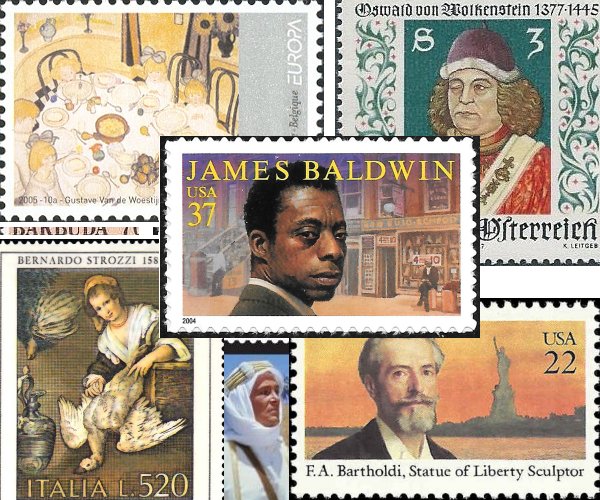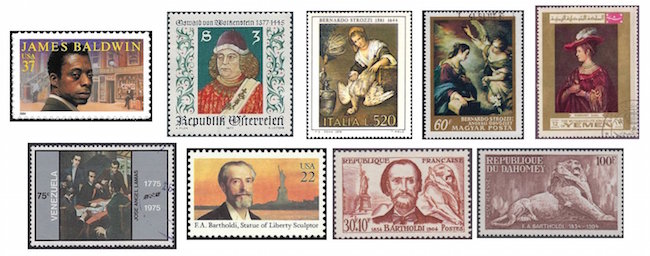The Arts on Stamps of the World — August 2
An Arts Fuse regular feature: the arts on stamps of the world.

By Doug Briscoe
Many painters in the offing today, but we begin with a salute to the great American novelist and essayist James Baldwin (August 2, 1924 – December 1, 1987). He sought escape from his rather nasty stepfather and from bullying by going to the library and falling in love with writing. Somewhere along the way he met Marlon Brando and shared a room with him. But in 1948 Baldwin left American racism for Paris, learning the language and making friends with the likes of Yves Montand and Marguerite Yourcenar. He would live in France for most of the rest of his life, though he was active on the American civil rights scene. The USPS honored him on a stamp in the year 2004.
Today is also the 572nd anniversary of the death of Oswald von Wolkenstein (born in 1376 or 1377, died August 2, 1445), an important composer of the period, as well as a poet and diplomat. His life was extraordinary, the earlier part of it being related in his remarkable monophonic autobiographical song “Es fügt sich“, in which he mentions having traveled to Crete, Prussia, Lithuania, Crimea, Turkey, the Holy Land, France, Lombardy, and Spain. At one point he was shipwrecked in the Black Sea. A landed nobleman, Oswald served the Holy Roman Emperor Sigismund as a diplomat and thus traveled even more extensively: England, Scotland and Portugal (where he took part in the Battle of Ceuta), even as far as Georgia. Wolkenstein was an extremely contentious and hotheaded person, constantly involved in various feuds and legal battles as well as frequently being active as a military commander in those unsettled times. In 1421 he was waylaid by some of his many enemies, by whom he was tortured and blinded in one eye (evident from his portrait on the stamp). There was a quiescent period in the mid-1430s, during which time, Wikipedia tells us, “almost no reports of fights, brawls or trials are preserved.” (I like the “almost”.) He was back in arms in 1439 against rebelling Tyroleans, but his death six years later was the result of an oppressive heat wave.

Italian painter and engraver Bernardo Strozzi was also known as il Cappuccino and il Prete Genovese. These nicknames came from the fact that Strozzi had become a Capuchin monk at age 17. He had already been apprenticed to an artist and continued his work while in the order. Eventually he left and took up residence in Venice, where his pieces included a portrait of the Doge and a now well-known portrait of Claudio Monteverdi. Born in Genoa around 1581, he died in Venice on this date in 1644. An example of his genre painting is seen on an Italian stamp of The Cook (c1625), and one of his religious works is the Annunciation (c1644) seen on an Hungarian stamp.
We’ ve already celebrated Rembrandt’s birthday this year, but I thought we’d revisit his world today for the birthday of his wife Saskia van Uylenburgh (August 2, 1612 – June 14, 1642) with a stamp left over from last month’s Rembrandt presentation (though the portrait itself, from c1633-34, did appear on another stamp on that occasion).
José Ángel Lamas (1775 – December 10, 1814) was a New World composer, born and died in Caracas, Venezuela. He wrote primarily sacred music and played the chirimía, an ancient medieval precursor of the oboe.
The designer of the Statue of Liberty, Frédéric Auguste Bartholdi (2 August 1834 – 4 October 1904), a Frenchman of German ancestry, was born in Colmar and studied art and architecture before turning almost exclusively to sculpture. He traveled to Egypt and there developed a taste for the monumental. Bartholdi took part in the Franco-Prussian War and, discountenanced by his country’s defeat, created a number of monuments in honor of his fellow soldiers, of which the most famous is The Lion of Belfort (1880), seen on a stamp from Dahomey. The idea for a statue to commemorate the American centennial was Bartholdi’s own. Of course, the statue, properly titled Liberty Enlightening the World, shows up on many stamps from the United States and other countries, but I thought I’d limit today’s offerings to stamps remembering Bartholdi himself.
American painter John French Sloan (August 2, 1871 – September 7, 1951) was born in Pennsylvania and lived there for the first 33 years of his life. There he met Robert Henri, William Glackens, and other members of what would become the unofficial “Ashcan school” of American painting. He and his wife moved to Greenwich Village in 1904, where he produced such representative “Ashcan” pieces as Sunday, Women Drying Their Hair (1912). But success as a painter eluded Sloan, who painted many canvases but earned his living from magazine illustrations. During World War I he spent his summers in Gloucester, Massachusetts, but for the next three decades he split his year between New York and Santa Fe, New Mexico. On the centenary of his birth the USPS issued an 8-cent stamp of The Wake of the Ferry (1907). Here’s a Self-Portrait Sloan painted in 1890.

Arthur Dove (August 2, 1880 – November 23, 1946) was among the earliest of American abstract artists. Works of this kind he first produced after visiting Europe with his wife in 1907-09 and with the encouragement of Alfred Stieglitz. Dove’s last representational painting was executed in 1910, and his first show, put on in 1912 with Stieglitz’s help, was the first exhibit of American abstract art in the United States. For a sheet of modern art stamps issued in 2013, Dove’s Foghorns (1929) was selected. The MFA houses many Dove pieces, including Tanks (1938).
Another, painter, this time a Belgian expressionist, is next. Gustave Van de Woestijne (2 August 1881 – 21 April 1947) studied at Ghent but destroyed all his student works and regarded the proper beginning of his career from his return to the countryside at the turn of the century. Like Strozzi, he entered a monastery but in his case gave it up after just three months. He taught at the Higher Institute of Fine Arts in Antwerp from 1927. Belgium has issued three stamps showing Van de Woestijne’s work: from 1981, The Spirit Drinkers (1922), from 1998 a fresco, Hospitality for the Strangers (1920), and from 2005, The Children’s Table (1919).
Mihail Jora (ZHOR-a, 1891 – 10 May 1971) was Romanian composer. He conducted the Bucharest Broadcasting Orchestra (1928-33) and taught at the city’s Conservatory (1929-62). Like Shostakovich and many others, he was accused of “formalism” in the 40s but was “rehabilitated” in 1953. His works include four ballets, a symphony, chamber, piano, choral, and vocal music.
Today’s fifth painter was a Norwegian, Håkon Stenstadvold (2 August 1912 – 7 October 1977). He studied in Oslo and Paris in the early 1930s, holding his first solo show in 1938. Among his most celebrated work is the series of illustrations he provided for an edition of Sigrid Undset’s novel trilogy Kristin Lavransdatter. Besides working as a journalist and art critic, he also held a number of administrative and municipal posts. I was not able to learn the name or date of the nature study seen on the Norwegian stamp from 2012.
French-Canadian singer-songwriter Félix Leclerc (August 2, 1914 – August 8, 1988) was the child of a Québécois pioneer family. He worked in radio in the thirties, writing drama scripts and performing his own songs on the air. In France from 1950 to 1953, he established himself as a successful performer and over the succeeding decades released twenty albums. Leclerc also wrote poetry and at least three novels and was active politically as a Quebec Separatist.
Our last painter for the day is the Australian Justin O’Brien (2 August 1917 – 17 January 1996). The child of devout Roman Catholics from Sydney (much of his work is infused with religious symbolism), he determined to become a painter while still in childhood. He served with the Australian Army Medical Corps in World War II in Palestine and Greece and was captured and held at a Stalag in Toruń, Poland, where he was permitted to exercise his craft. Prior to that, however, he had seen a mass grave of Greek civilians who had died of famine, an image that remained with him until he put it to canvas as The Greek Burial after the war. (A variant or study of this work, in pen and ink with colored wash, also exists.) Much assisted by private patrons and a gallery that offered him chances to exhibit, he “paid it forward” with encouragement to a number of young artists. I find no specific reference to homosexuality, but a favorite and recurring theme in O’Brien’s work was nude male youths, as in Boys in a Bathing Shed. In 1954 O’Brien renounced his Catholicism. He spent the last thirty years of his life in Rome. The Australian Christmas stamp from 1980 shows a detail from his triptych The Virgin Enthroned (1950-51).
The great Irish actor Peter O’Toole (2 August 1932 – 14 December 2013) would have turned 85 today had he not died four years ago. One of his most famous roles, as David Lean’s Lawrence of Arabia, was featured on a recent British stamp.
Happy birthday to Chilean-American writer Isabel Allende (born August 2, 1942).
A graduate of the University of Massachusetts with a B.A. in English, Doug Briscoe worked in Boston classical music radio, at WCRB, WGBH, and WBUR, for about 25 years, beginning in 1977. He has the curious distinction of having succeeded Robert J. Lurtsema twice, first as host of WGBH’s weekday morning classical music program in 1993, then as host of the weekend program when Robert J.’s health failed in 2000. Doug also wrote liner notes for several of the late Gunther Schuller’s GM Recordings releases as well as program notes for the Boston Classical Orchestra. For the past few years he’s been posting a Facebook “blog” of classical music on stamps of the world, which has now been expanded to encompass all the arts for The Arts Fuse.
